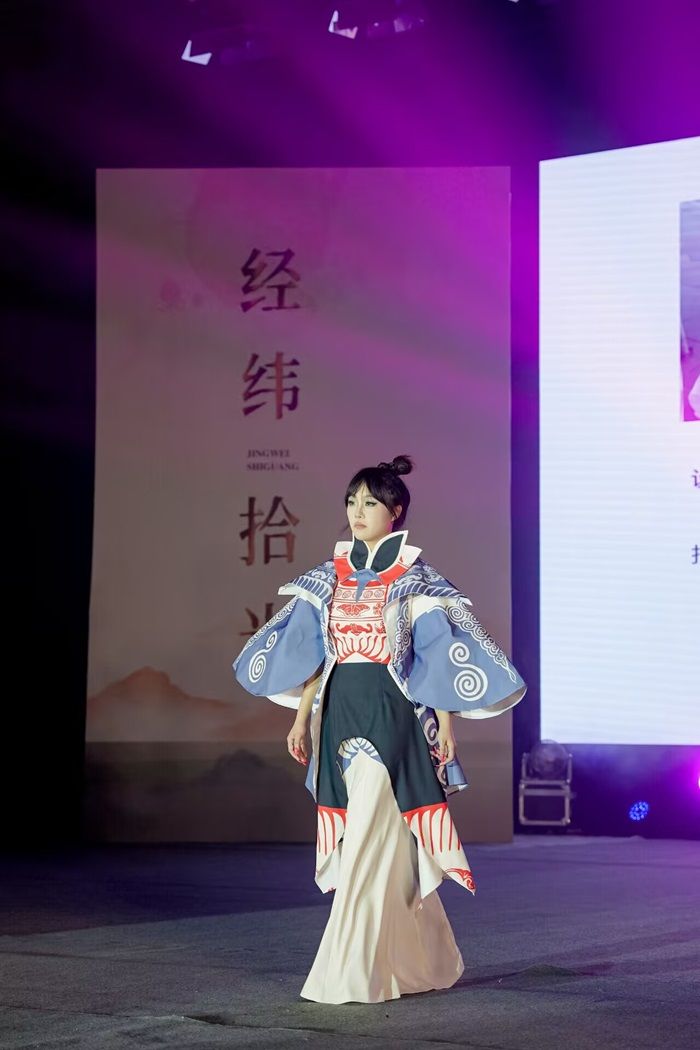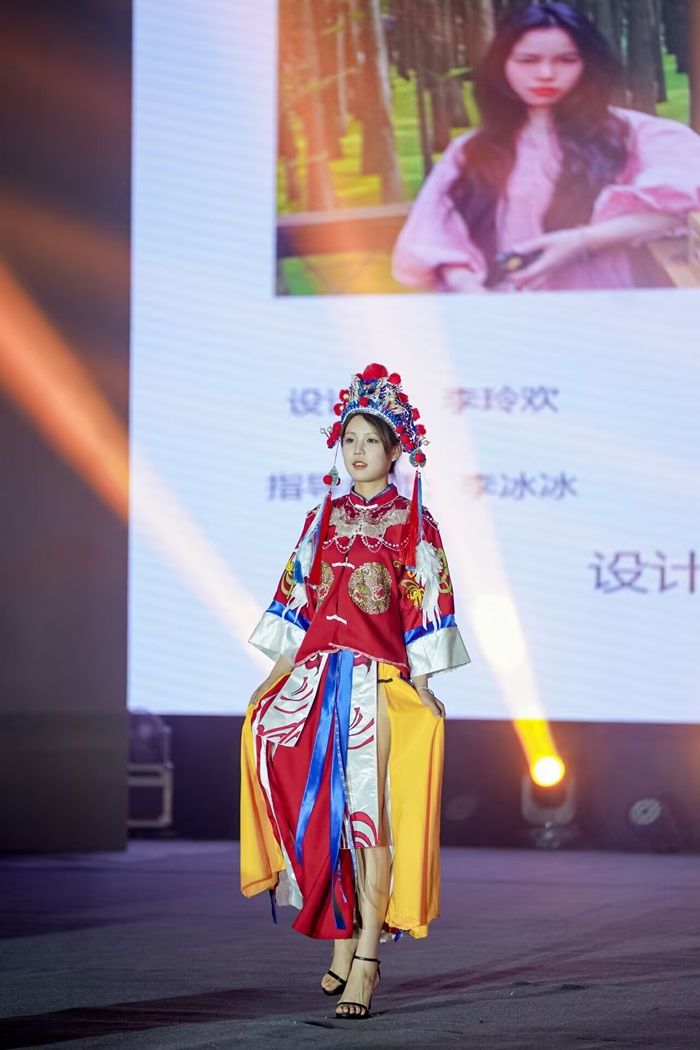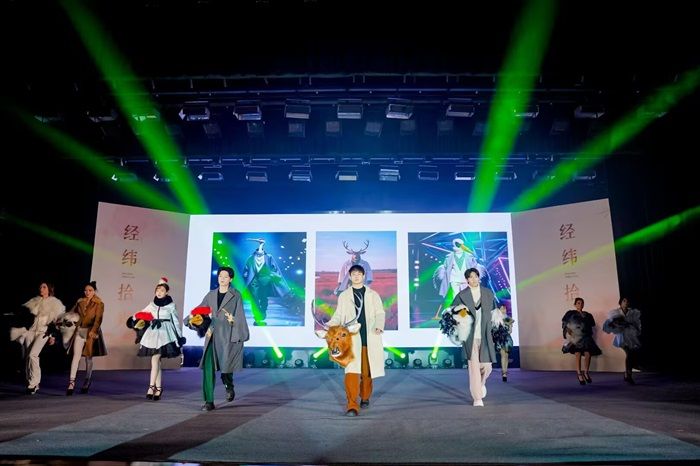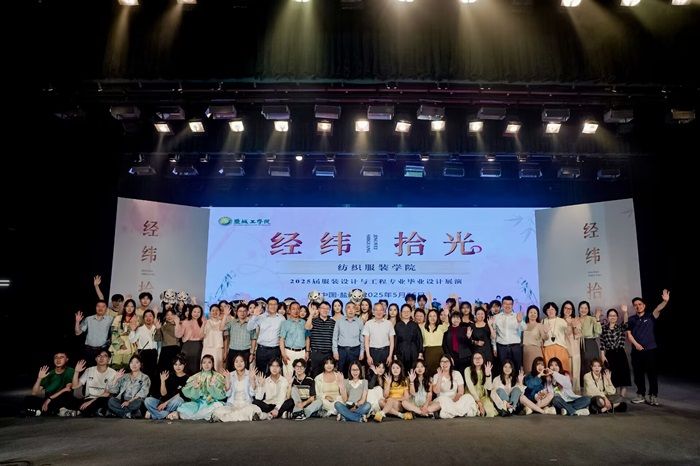IOn May 26th, the School of Textile and Fashion’s 2025 Fashion Design and Engineering “Jingwei Shiguang” Graduation Design Exhibition launched at YCIT campus. The event was presented simultaneously through a combination of on-site viewing and online photo livestreaming. Leaders from various university departments and schools, and representatives of teachers and students, watched the exhibition.
This exhibition, themed “Jingwei Shiguang”, uses “Jingwei” to signify the vertical and horizontal integration of traditional craftsmanship and modern technology, while “Shiguang” symbolizes the refinement of cultural essence and the capture of contemporary style. A total of 45 series comprising 181 graduation design works were showcased. Students drew inspiration from intangible cultural heritage such as Huai Opera, blue calico, and paper-cutting. Employing techniques like weaving, patchwork, and embroidery, they ingeniously merged Eastern aesthetic elements like cloud patterns, bronze vessel motifs, and ethnic totems with Western elements like Gothic geometric lines and Rococo intricate embellishments. This demonstrated innovative interpretations of Chinese traditional culture and the cultivation of an international fashion perspective.
On the T-stage, designs integrating blue calico, paper-cutting, Yi ethnic craftsmanship, and opera elements endowed traditional techniques with contemporary expression; Rococo style revived European classical aesthetics through layered ruffles and court-style tailoring. Paper-cutting elements presented diverse new Chinese-style garment designs through hollow-cut techniques, highlighting the modern transformation of intangible cultural heritage skills. Ink-wash painting inspired works simulated the artistic conception of landscapes through gradient dyeing on fabrics. Blue calico series innovated garment tailoring forms, showcasing traditional beauty through asymmetry, draping, and other styles. Cloud pattern designs, extracted from Han Dynasty lacquerware motifs, endowed garments with dynamic beauty through padding, printing, and other techniques. Ethnic themes focused on the fusion of traditional silver ornaments and homespun fabric textures. Naturalism simulated plant growth forms through biomimetic garment design. Different design styles and the collision and symbiosis of various elements constructed a cross-temporal aesthetic dialogue, creating a matrix of innovative cultural heritage within the confines of fabric.
Rooted in regional characteristics to showcase wetland beauty, the event featured an additional “Wetland Spirits” T-stage show. This series was based on the AI “Wetland Spirits” T-stage show that went viral online at the end of 2024. Commissioned by the Yancheng Publicity Department, teachers and students from the School of Textile and Fashion participated in this creation over six months. On the runway, models wore creative apparel custom-made with wetland elements such as elks, red-crowned cranes, and spoon-billed sandpipers, perfectly recreating the agility and elegance of the “Wetland Spirits”. It showcased natural beauty through ecological design and technological integration, while also demonstrating the enthusiasm of the school’s teachers and students in serving the local community.
Applause echoed throughout the venue, and attendees enthusiastically took photos. Wang Chunxia stated that the school consistently embeds local construction and industry demands throughout the entire teaching process. Through collaborative course development with enterprises and the joint construction of practical platforms, students seamlessly transition between design drafts and production lines.
Deepening industry-academia integration to serve the local industrial chain, the school has continuously advanced the “Visit Enterprises, Expand Posts, Boost Employment” initiative in recent years. It has established industry-academia-research bases with companies like Guotai Huasheng, Jiangsu Junlin Textile Technology, and Yueda Home Textiles. The school organizes teachers and students for practical studies at renowned enterprises like Zhihe, creating a dual-driven teaching model of “Professional Education + Enterprise Practice”. The employment rate of the 2024 graduating class exceeded 97%. The Fashion Design and Engineering is grounded in the “Art-Engineering Integration” teaching philosophy, establishing a “Basic Theory + Practical Innovation + Industry-Academia Collaboration” trinity talent cultivation system. The curriculum covers core courses such as Garment Structure Design, Garment CAD, and Draping, and incorporates cutting-edge content like Style3D, cultivating students’ full-chain capabilities from design to production. In the future, the school will continue to promote the cross-disciplinary integration of “Design + Technology + Culture”, injecting youthful dynamism into industry innovation and urban development.



